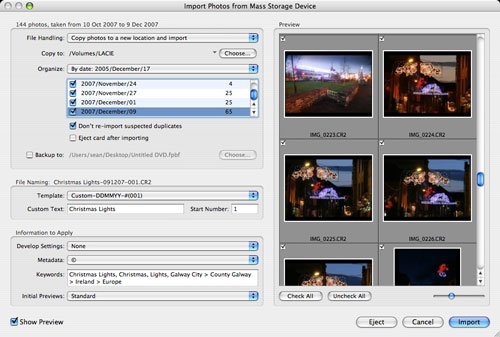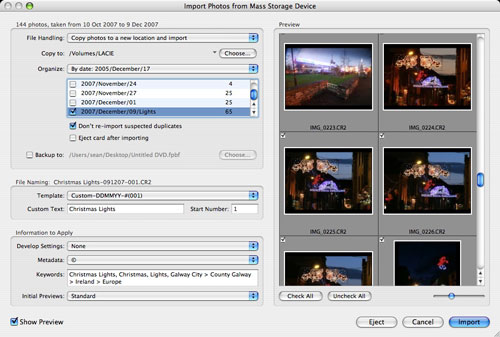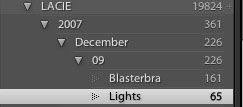A recent near miss with serious data loss has me rethinking my current import by genre strategy. In a fairly recent post on Lightroom Forums.net, John Beardsworth argues for always importing by date and using metadata to create any other required structure. The background to this post by him is that I was touting a structure like Landscapes>Ireland>Connemara>Bunowen, rather than by date.
“Unless you use a strictly date-based structure, there is always the risk of your pictures either being duplicated or falling between the cracks and being controlled only in your imagination. Where, in Sean’s example, would one put a shot that fits more than one category – a portrait in a bleak Connemara landscape. In bands, or in Connemara? Why not in both? Or should it depend on the size of the person relative to the landscape. A second set of considerations is reconstruction – imagine a catastrophic system failure and what makes rebuilding easier. A subject hierarchy or simple date based folders? In other words, using your folder system to analyze your work is a dead end – that’s what metadata is for.”
My issue began when doing some backup. Somehow the power supplies of my archive drive and the backup drive became swapped and both drives crapped out (the somehow being my own stupidity, I suspect). I surmised that perhaps the 12v and 5v lines were swapped in each (they have identical connectors) and that by swapping the drives and the caddies, I might get one working. I was right and managed to avoid serous data loss through this. Needless to say I bought a new drive immediately and backed up the photos.
Now I did have most of the stuff on DVD also, but newer stuff wasn’t there because my DVD backups were monthly at the very least. Since I changed to using 2 drives for backup, I’ve been lazy about using this procedure. Also the Genre method makes it hard to save monthly. I’m back to importing by date now, but with one change.
I want to have my shoots in their own folder. Sometimes I might have 3 or 4 unrelated items in one day, eg portraits during the day, band promo shoot in the evening and a live gig at night. I don’t want these together in one folder, so here’s where a simple bit of typing can help.
Currently Lightroom only allows one set of metadata/keywords/settings at a time on Import. Because of this I tend to do multiple imports from one card if need be. So to decide my import location I now choose the 2005/December/17 style date import as per Fig 1. (I could also use 2007/12/07, but I like seeing the month name.)

Fig 1.
I then double click on the folder name that is being applied to edit it. I leave the date string intact as 2007/December/09, but I add to with a /Lights. The leading “/” forces Lightroom to create a new subfolder in the date folder. You can see the full string in Fig 2.

Fig 2.
With 2 shoots from that date imported in the same way, I have the shoots in individual, but date based folders.

Fig 3.
Of course now I need to consider how to get my older folders into this order. I have a few options: Use dates from the Metadata Browser to manually create dates and move the subfolders to these. I could simply save out all the Metadata and remove the files and reimport by date. I’d lose Virtual Copies and Collections this way though. Any option I choose forces compromise, so this will dictate the choice. As an interim option I could also simply make a date/month/subfolder option for now and add the date as time allows. I suspect the latter choice will be the easiest, with least loses.
And now John will get a chance to say ‘I told you so’.












I originally posted these comments in LR News a day or so back, but thought they may be better off here.
Maybe for the virtual copies, one could simply render out a JPEG/PSD/TIFF of each, so at least you have a visual representation of the variation. This could prompt you to recreate in LR or if you aren’t too bothered about the space, simply keep the actual copy.
If LR could write a VC xmp file to go alongside the main XMP file or better if LR could write the VC data into the main XMP file, then the problem would be solved.
To go back to the main part of thread. I always file by date, simply as it’s programme agnostic and very robust. I can copy my data from PC to Mac or vice versa and still have all my date heirachy.
I will want to access my files in 20years time. So relying on my still using LR then is a bit daft, it could be replaced just as LR has replaced PS for many people today, which would have been inconcievable to many a few years back.
Though if my data is in date order with keywords, then I have the best of both worlds. As one shoud be able to easily import the folders and read the keywords with any decent library software.
I have folders labelled by day [2007 – 12 – 25 Xmas in Grenoble], So not only do I have date but information as to what’s in the folder, saves having to open it or reminds you what is in it. Much easier than using metadata at times. I may even have several folders for each day, if the contents vary enough [2007 – 12 – 25 Xmas Lunch, 2007 – 12 – 25 Post Prandial stroll, 2007 – 12 – 25 Xmas Present opening – a bit of overkill for Xmas maybe, but when busy shooting more varied things, it’s very handy]
I use this numerical label rather than 2007 – December-25 as otherwise that will be ordered before 2007-September-25, by the OS. So I also have monthly folders labelled with 2007 – 01 January, 2007 – 02 February…2007 – 12 December into which I then place my daily shoots.
I also prefer 2007-12-24 as it’s more readable and way, way better than the 20071224 nonsense I’ve seen recommended by supposed DAM gurus.
And files are always named 2007-12-14 ‘Description’ 001.CR2 i.e. date+name+number. I used to have date after name like you do, but that proved to be a pain, so date goes at front first now. Though sometimes it can be better. Always a compromise!
A way to get all your images into date order folders is to copy them using LR to another location and let LR arrange into date folders. I did this the other day for a colleague with a mess of images after he used iPhoto to ‘organise’ his pics. Nothing had been named either. So by getting LR to copy to a new location, it also helped find and get rid of 1/3rd of the images that were duplicates too.
That might assume I don’t having a naming convention that already deals with that very subject.
My standard naming convention is
CustomText-ddmmyy-#seq001
So I can tell exactly when it was shot without looking at anything other than the filename.
The reason for this is that I shoot certain things repeatedly.
I’m with John on this one — I use 2007/2007-12/2007-12-17 rather than just 2007/12/17 so that when I’m looking at a single folder, I can tell what month and year it belongs to.
Of course, if you want to learn that hard lesson on your own, who am I to stop you? 🙂
[Actually, I use 2007/2007-12-17 instead of my preferred 2007/2007-12/2007-12-17 because the templates are not editable. Sigh.]
At least on the Mac Lightroom will keep track of a file that is moved as long as it stays on the same volume. If you don’t mind the comand line, exiftool will let you batch move images based on the EXIF date providing an easy way to reorganize your existing images. So something like:
% cd my/images/dir
% exiftool ’?Directory
or if you wanted to add a shoot suffix something like:
% cd top-level
% exiftool ’?Directory
should do the trick. It won’t handle sidecar files though — I don’t know if that’s important to you or not.
I switched to a version of this organization a few months ago…so I didn’t have a ton of pictures to re-organize.
I let Lightroom import by date….2007-12-07, then once inside LR I right-click the folder, and add a two letter state identifier for the location of the shoot(e.g.IN-for Indiana), then a short description. so it might look like…
2007-12-07-IN-Davis Wedding.
I told…. No, you’re lucky I’m chilled out right now!
Sean, I’d shoot for a lowest level folder name that includes all the date information – so the files would be in a YYYYMMDD folder. They may be within a YY and a MM, but they’re not essential. At some point, in some application, you may need to sort by the date of the folder. That’s something you’ll not be able to do if your lowest level folder isn’t unique, which is what happens with YYYY/MM/DD structures.
Hi Pindy,
The post actually came from that / tip. The back story fluffed it out though 😉
Jeffrey,
back when I was manually organising my files, the 01 Jan method would’ve been the one I used. My point about the change is that I would only require renaming the month to a number if need be, ie only one small thing would need to change.
Hi David, that’s exactly what I’m doing.
I double click and the field becomes editable. I then right arrow to unselect the text and add in the / and whatever I want.
This field has been editable since at least beta 2, if not earlier.
Great tip about the leading slash. I started the thread you referenced, so I’m glad to see more discussion about this. I’d love to see a way to re-organise the existing photos into folders or to re-import without writing XMPs to every photo and blowing them out of the catalogue.
FWIW, since Beta 5 (e.g. for about the last year) I’ve used the following pattern and have been very happy with it:
YYYY/MM/DD-description/
For example,
2007/12/07-Christmas-Tree/
Unless you have a lot of different shoots every day, there’s little benefit to having a day-of-month folder instead of combining that number with the description. Combining them avoids having such a deep folder tree, and, more importantly, keeps more of what’s important in view at once.
Some days I’ll have three or four shoots, but most days it’s just one major outing, so the month folder (“12” in the example above) remains manageable. On the other hand, if I had 10 shoots every day, I’d probably drop in that extra day-of-month level.
About Sean P’s comment, don’t underestimate the sorting power of “12” over “December”. Perhaps consider “12-Dec”?
Lol, not so hard really, double click and rename. We’ll see how it goes!
The problem with using 2005/December/17 style date import
rather than 2007/12/07 is that using the name of the month will end up in the subfolders within the Year folder being in alphabetical order, which is not the same as the numerical (or chronological) order, which is simply not intuitive.
I say fix it now so you don’t have to go back and do it later!
Sean, perhaps I am missing something but I am not able to edit the “Organize: By date:” with a double click.
To be sure I understand what you are doing.
Upon import from a device you select the organizing of dated folders and then double click the date text (next to the ticked box)
Mac: Leopard. Lr 1.3.1
any ideas as to why I am not able to replicate your post?